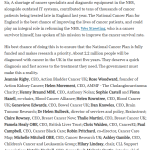Colloid Cyst support and events
A brain tumour diagnosis affects many areas of our lives and brings with it complex challenges. Things may never be the same as they were before, but brainstrust can help you to live well with a brain tumour, so you can have your best possible day – whatever that looks like for you. We’re here to help you be in control of your care, so that you feel involved, supported, and confident that the choices you make are the right ones for you. Because you are more than a patient, you are a person. We can help you get back to being you.
brainstrust resources
The following list of brainstrust resource cover a range of topics and have been created in consultation with the community and experts in the field so that they provide you with the information need to feel well-resourced and in control:
provide you with the information need to feel well-resourced and in control:
- Brain tumour patient guides let you know what care to expect as a brain tumour patient.
- Information about common brain tumour treatments (surgeries and therapies).
- Help to live well with a brain tumour.
- Practical help for living with a brain tumour.
- Resources for taking control.
All of our resources are free to download from our downloads and resources page. As well as the resources sign-posted above, on this page you will also find our Know How resources which cover a wide range of topics from how to have difficult conversations all the way through to the practicalities of driving with a brain tumour.
Our monthly Colloid Cyst meetup
We believe there is great value in having conversations with people going through a similar experience. If you are looking to speak to other people with a Colloid Cyst, come along to our monthly virtual meetup on Zoom. Keep an eye on our Events page for details of our meetups. Click here to go to our events page.
The brainstrust colloid cyst page has been my only source of support as I feel it’s been lacking from my Neurosurgeon. It’s a safe place to ask questions and get real answers from people who have or are going through this emotional rollercoaster. I want to thank brainstrust, I feel like they are the only ones who actually care.
– Colloid cyst patient and colloid cyst group attendee
Further support and research
Head to our PRIME page to find out more and get involved in vital clinical research.
If you have been affected by a brain tumour diagnosis, please reach out to us by calling 01983 292 405, visit our support area or email hello@brainstrust.org.uk
Help fund our mission
Our work leads to a 20% decrease in loneliness for people we support.
Just £5 a month could help us host our monthly Acoustic Neuroma meetup helping us connect more people with others who understand.
Did this information make you feel more resourced, more confident or more in control?
Subscribe to our mailing list to hear about all the latest news, events, research and resources.











